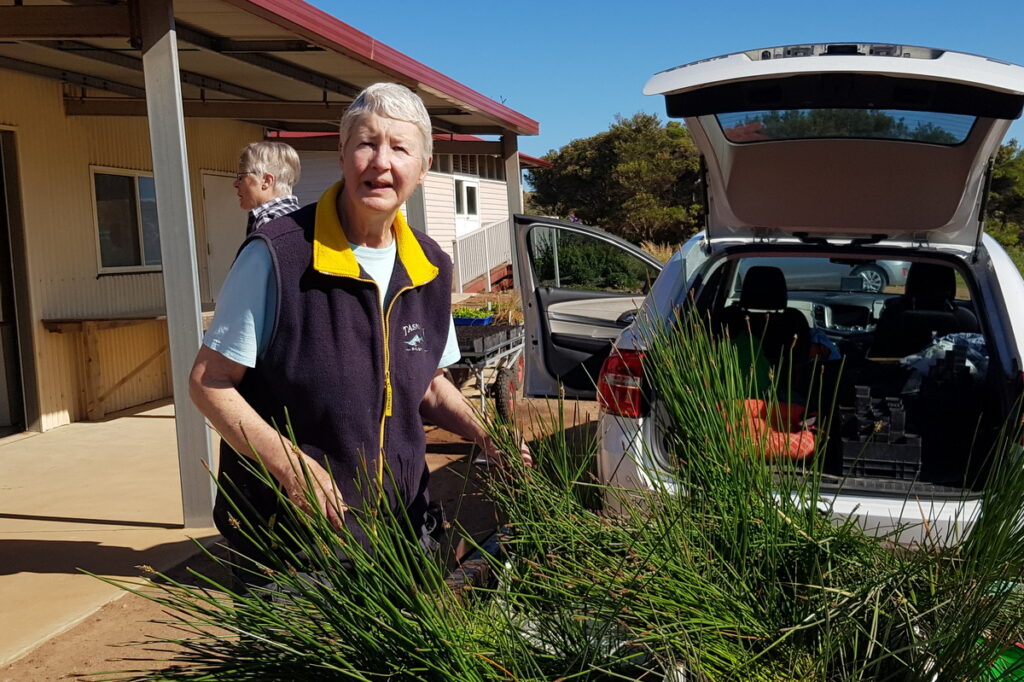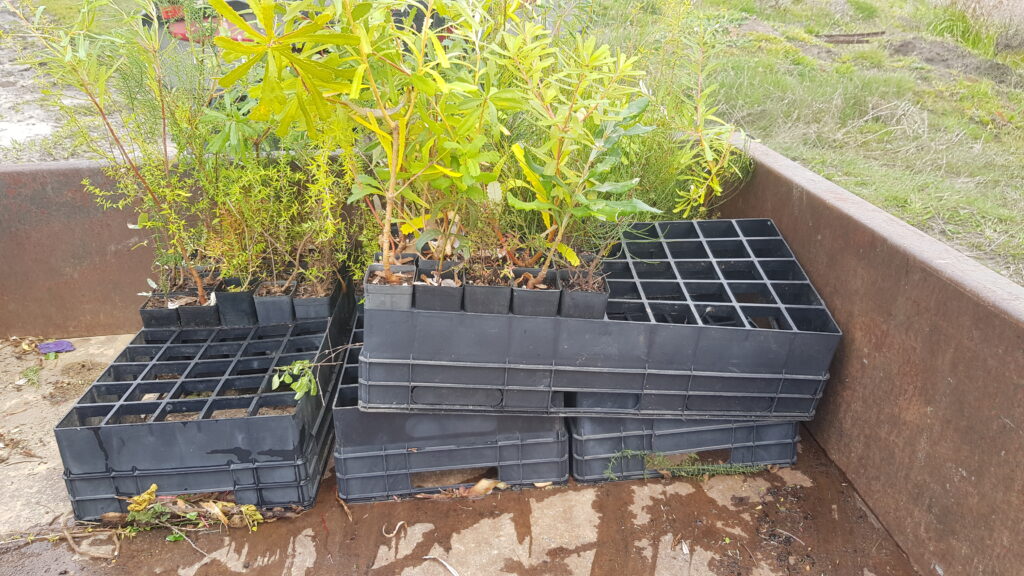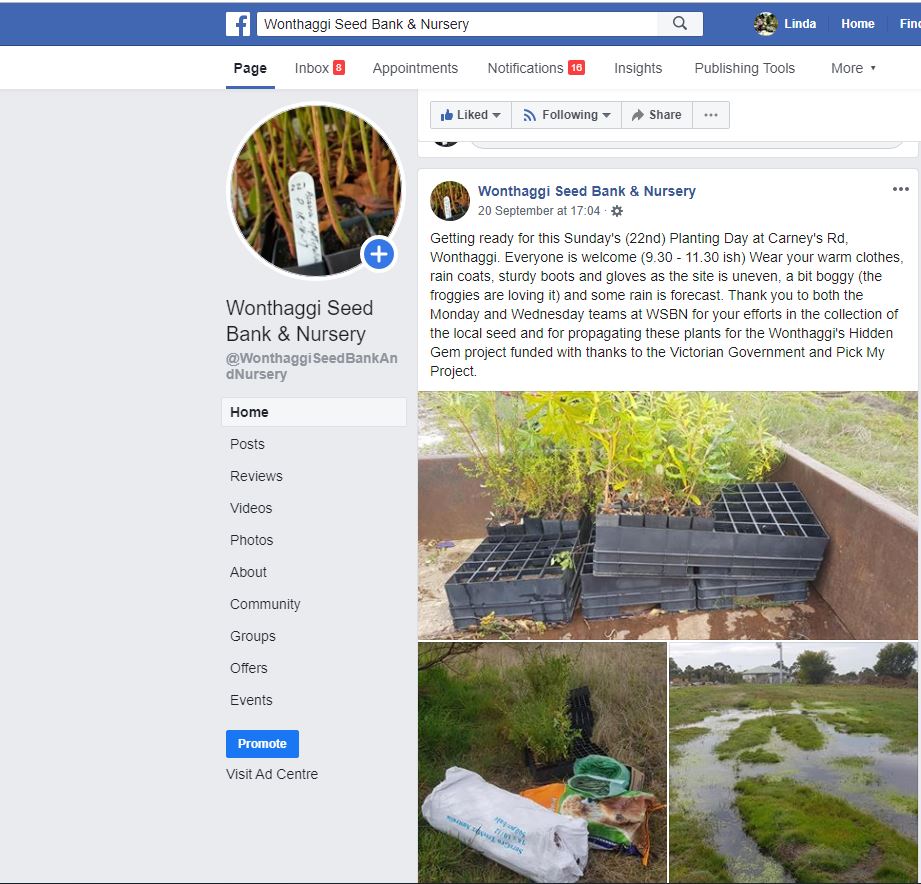The ‘Wonthaggi’s Hidden Gem and Ecosystems for the Future’ project is being undertaken by the South Gippsland Conservation Society (SGCS) made possible through the Victorian Government’s funding in 2019 through ‘Pick My Project’.
What role does WSBN have in this project?
WSBN has an association with the project through the revegetation activities for the three Ecological Vegetation Classes (EVCs) that have been identified for the site. These include revegetation for Damp Sands Herb-rich Woodlands, Damp Melaleuca Scrub and Tall Marsh classes. The site also includes an ephemeral wetland and significant work has been undertaken to identify the appropriate species for revegetation when the construction of the wetland is completed (2020). WSBN Volunteers have also been propagating the aquatic and wetland plants over the past few years for this site and look forward to some muddy activities later this year as the plants find their forever home!
Significant funding, expertise and resources from our community have had a role in this project:
- The Victorian Government provided major funding through ‘Pick My Project’ – 2019
- Bass Coast Landcare provided funding for 3,000 plants, which were propagated and supplied by the Wonthaggi Seed Bank and Nursery -2019
- WSBN Grant funding through Bass Coast Shire Council for the installation of a barrier fence to protect the area from inappropriate activity – 2019
- SGCS is funding the 2020 revegetation activities and this will also include the wetland plants. Further funding has also been pledged for revegetation – 2021
- Parks Victoria has contributed numerous resources with personnel (vale Bill Slade) on site assisting with their expertise and often their resources – 2019 ongoing
The Wonthaggi Seed Bank and Nursery will continue to be the key provider for the revegetation species for this project. Thank you WSBN Volunteers for your care with the project’s plants.












Background
The map below shows areas of public land around Wonthaggi. Historically these land parcels have been ‘under-mined’ and were identified by the Land Conservation Council as ‘Land not required for public purposes’. Fortunately at the time, local people with an interest and passion for conservation formed organisations and ‘action groups’ to campaign the relevant government agencies at the time to realign these land parcels as places for conservation and recreation. Some of these people were the founding members of WSBN and in fact the sites were and still are used for indigenous seed collection by group members.
The extent of these reserves is unique to Wonthaggi and provides many opportunities for protection of bushland, flora and fauna as well as opportunities for a connected network of walking trails across different landscapes and recreation connections to the coast, hinterland and township. It is only in more recent times that the foresight of these people is now being truly valued as a community and environmental significant asset.
The map below references ‘Number 11 Carney’s Bush’. This is the site for the Pick My project funding, currently referred to as ‘Wonthaggi’s Hidden Gem and Ecosystems for the Future’.
Map – Land Conservation Council Victoria – circa 2008:

A bit more about the ‘site’ now moving forward – circa 2019-2020
On the eastern outskirts of Wonthaggi, Carney’s Rd is the last road turning off the Bass Hwy and heads south towards the industrial estate and beyond.
The 11 Ha Crown Land site, under the auspices of the Department of Environment Land, Water and Planning (DELWP), is bordered on three sides by bushland managed by Parks Victoria. SGCS has leased the land from DELWP to manage this site. Obligations under the various permits for the site focus on revegetation with indigenous plants to increase biodiversity and respect for our indigenous cultural heritage associated with the original landowners.
WSBN has had a long history with the SGCS and it is exciting to now see how the efforts in the past for conservation are being realised through the Pick My Project initiative that can engage both Volunteer organisations.
Sentinel Times 2018 – Pick My Project media:

Why Pick My Project funding?
The Pick My Project (PMP) funding guidelines were a good fit for the site. Given that the site was originally saved through community action, it was appropriate that this funding opportunity came about via a community vote. The open land and the remnant bushland were becoming more and more degraded. The site was being accessed inappropriately for illegal waste dumping, 4WD and motorbike use. Vehicle tracks became deeper and wider and retaining the site for environmental conservation was eroding. It was time to act when the PMP funding opportunity came about. The lobbying and funding application process began in 2018.
The project vision…
A significant area of the site will be revegetated with indigenous vegetation; a small ephemeral wetland will be constructed that is part of the wider Powlett River catchment. A boardwalk will be built behind the ephemeral wetland providing great viewing across the wetland. Remnant logs from the site have been relocated for viewing and resting seats for people and wildlife. More detail is provided further on.
Project permits…
The Carney’s Rd site has a small area of a Cultural Heritage Sensitivity Overlay located in the South West corner. An initial meeting with the Bunurong Aboriginal Corporation Land Council, our Consultant and SGCS was held to discuss the project details. The approved Cultural Heritage Management Plan requires us, amongst many ongoing obligations, to safeguard any Aboriginal cultural sensitivities and heritage as we undertake earthworks for the wetland in the designated activity area.
The Revegetation Management Plan (Oates Environmental Consulting Pty Ltd) has been completed and approved by DELWP. This involved several site visits to identify plant species on site and those that were likely to have been present before grazing and other land use.

Revegetation activities…
Working Bees held to date with local Volunteers from SGCS, WSBN and other community groups have so far planted 3,000 indigenous plants in their forever home!
The species listed below are all available for sale at the Nursery. The links below take you to our Plant Fact Sheets. The ‘Plants‘ web page includes a PDF that can be downloaded that lists all our plant species. The ‘Orders‘ web page includes an Order Form.
2019
2019 revegetation included the following plant species: Acacia mearnsii, Acacia melanoxylon, Acacia verticillata, Allocasuarina paludosa, Eucalptus kitsoniana, Leptospermum myrsinoides, Melaleuca ericifolia, Myoporum insulare andViminaria juncea











2020
2020 revegetation will include: Acacia mytifolia (broad leaf), Acacia suaveolens (narrow leaf), Banksia marginata, Eucalyptus obliqua, Eucalyptus viminalis ssp. pyryoria, Eucalyptus radiata, Leptospermum mysinoides and additional species from the 2019 list.
2020-2021 Wetland species
2020 wetland revegetation will include: Carex appressa, Crassula helmsii, Cycnogetum procerum, Eleocharis sphacelata, Juncus holoschoenus, Juncus pallidus, Juncus subsecundus, Myriophyllum spp*, Persicaria decipiens and Ranunculus inundatus
How do you build an epehemeral wetland & boardwalk?
Survey levels and why does that affect WSBN?
Survey levels were undertaken to identify the location for the ephemeral wetland and boardwalk on the project site.
A design was prepared. Understanding the site’s environment (in this instance being ephemeral) and the site’s levels assists us to identify appropriate plant species for the spaces. Some wetland species enjoy and thrive with their ‘feet’ always wet or mostly wet. We include these species in our Plant List, categorising them as ‘Aquatic/Wetland’ (e.g. Ranunculus inundatus).
For species that enjoy sometimes being wet or moist we have categorised in our Plant List as ‘Grasses, Sedges, Rushes’ (e.g. Persicaria decipiens). Many of these plant species can thrive in both environments (e.g. Carex appressa).
It is important to consider all seasons when planting a wetland and gaining some specialist advice from one of our WSBN specialists (contact@wsbn.org.au) before you start can be very worthwhile. Shown in the image below is work being undertaken on site to establish all survey levels.
Visit Wetland Planting for more information.

Watch this space for further updates associated with the wetland construction – coming soon…
Keeping up with community projects in which we have a role…
WSBN has a Facebook page and we regularly update this with information about the community projects we have a role in.
Please visit and ‘like’ us at https://www.facebook.com/WonthaggiSeedBankAndNursery/

More: Wetlands Enhancement | Rifle Range | Walking Wonthaggi’s Wetlands | History
